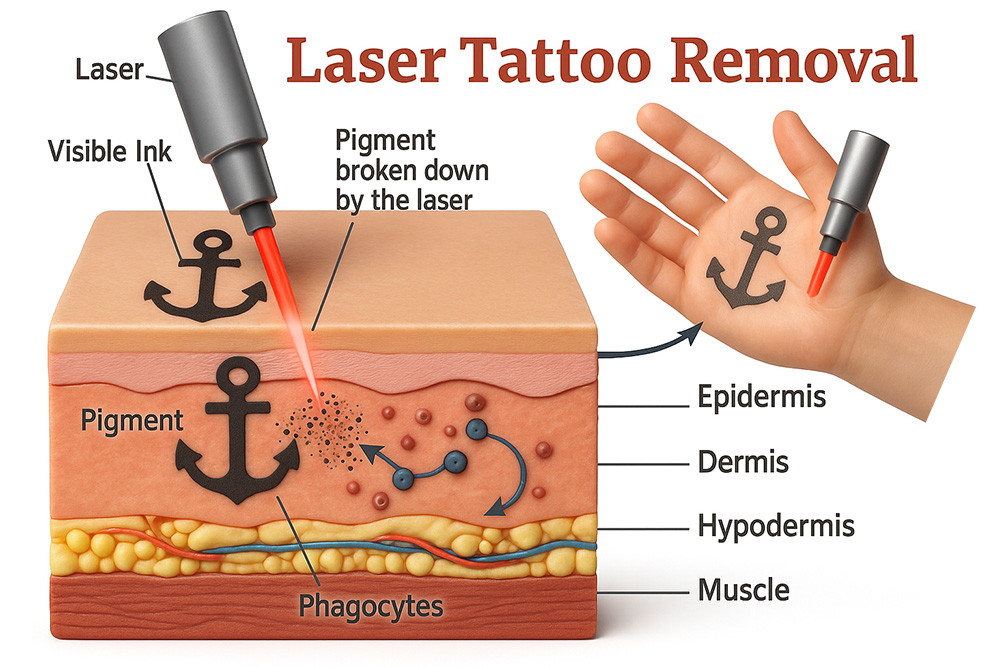Laser tattoo removal costs in the UK typically range from about £70 for very small black pieces to £300 plus per session for larger or multicolour designs, with most clients booking a course of sessions. The exact figure depends on tattoo size, colours, density, and the device used. Here is a clear pricing breakdown for clients and clinics, plus ways to keep costs sensible without cutting corners.
Table Of Content
What actually sets the price
- Size and coverage: more surface area means more time on the laser and more passes.
- Colour complexity: black absorbs efficiently and usually costs less. Reds, blues, and greens need additional settings and sometimes more sessions, which raises spend. See colour challenges on WebMD.
- Ink density and layering: professional, layered, or cover up work takes longer than light amateur lines.
- Sessions required: full removals often need six to twelve visits. Fading for a cover up is usually fewer.
- Technology and operator skill: clinics using true Q switched Nd YAG with strong energy and cooling can work faster and safer, which supports better value.
Side effects such as redness, swelling, and occasional blistering are usually short lived when aftercare is followed, as outlined by the NHS Bristol Laser Centre.
Typical UK prices by size
Guide figures for clinics using professional Q switched Nd YAG devices. Course discounts are common and reduce per session spend.
| Area or size | Per session | Course of 3 | Course of 6 |
|---|---|---|---|
| 1 inch squared, black | £70 to £85 | £195 to £230 | £390 to £460 |
| 1 inch squared, multicolour | £95 to £110 | £260 to £300 | £520 to £600 |
| 2 inch squared, black | £90 to £105 | £240 to £280 | £480 to £560 |
| 2 inch squared, multicolour | £115 to £135 | £315 to £360 | £630 to £720 |
| 3 to 4 inch squared, black | £110 to £140 | £300 to £380 | £600 to £760 |
| 3 to 4 inch squared, multicolour | £135 to £165 | £360 to £450 | £720 to £900 |
| 5 inch squared, black | £140 to £170 | £380 to £460 | £760 to £920 |
| 5 inch squared, multicolour | £165 to £190 | £450 to £520 | £900 to £1,040 |
| Eyebrow cosmetic tattoo | £85 to £110 | £240 to £300 | £480 to £600 |
Clinics typically price by measured area, not by body part, so bringing dimensions and clear photos to consultation helps secure an accurate quote.

01. What you pay for, beyond laser time
- Consultation and assessment: tattoo mapping, colour profile, depth, medical history, photos, and a patch test.
- Certified operators and devices: look for trained practitioners using a genuine Q switched Nd YAG with both 1064 nm and 532 nm. Our Nu Tatouage Plus delivers high pulse energy and dual wavelengths for black and coloured inks.
- Cooling and aftercare: good cooling builds comfort and limits downtime. Aftercare sheets and follow up support are part of professional pricing.
- Course discounts: buying three or six at once usually trims ten to twenty five percent from the per session fee.
How many sessions will you need
- Design and colours: single colour black linework clears fastest. Reds respond well at 532 nm. Greens and blues can need more visits.
- Tattoo age and depth: older, already faded ink lifts more easily than fresh, dense pigment.
- Goal setting: full removal commonly needs six to twelve visits. Fading for a cover up is often three to six.
Spacing is key. Six to eight weeks is usual so your immune system can clear fragmented pigment before the next pass. This pacing improves safety and efficiency, a point echoed in clinical reviews such as JAMA Dermatology.
Technology features that improve value
| Feature | Why it helps pricing |
|---|---|
| Dual wavelength Q switched Nd YAG | Covers black and common colours in one platform which reduces rebooked corrective passes |
| High pulse energy and stable beam | Efficient pigment fragmentation, shorter appointments, fewer sessions in many cases |
| Low running cost | Our Nu Tatouage Plus runs at less than one penny per forty shots which helps clinics keep fees competitive |
| Reliable support | Rapid swap or repair avoids schedule disruption and duplicate client visits |
02. Ways clients can trim spend
- Choose qualified providers: insured, certified technicians using modern Nd YAG. You are paying for safe, efficient progress rather than cheap repeats.
- Book courses: multi session bundles lower the unit price and keep you on schedule.
- Follow aftercare: fewer incidents means fewer delays between sessions which keeps the course shorter.
- Set the right goal: if a cover up is planned, ask for a fade plan. It usually costs less than full clearance.
For result expectations beyond cost, read our guides on tattoo removal effectiveness and the science piece on how removal works.
For clinics: price confidently with the right kit
The Nu Tatouage Plus pairs high pulse energy with dual wavelengths at a very low cost per treatment, so you can price fairly and still protect margins. Flexible handpiece or footswitch control, dual shot counters, and durable components keep workflow smooth. Add our Cryo 6 for client comfort. Training is included and supports insurance and local compliance. Want to see it live. Book a demo or request details for finance options. Need governance help. Our Laser Protection Advisor service is available.
03. Quick answers on pricing
- What is the average total spend: many clients pay between roughly £450 and £1,600 across a year depending on size and colour mix.
- Why quotes differ: device capability, pulse energy, and operator experience change session length and count.
- Can every colour clear: not always. Yellows and whites can be stubborn. Skilled fading still opens the door for a clean cover up.
Industry demand remains lively, with many UK providers adding laser removal to their menus as reported by sector sources such as VTCT reporting.
Key takeaways on cost
- Session pricing: roughly £70 to £300 plus depending on size and colours, with course bundles lowering per session fees.
- Total course: six to twelve sessions is common. Spacing allows natural pigment clearance and safer progress.
- Best value setup: dual wavelength Nd YAG, high energy, strong cooling, and certified operators.
If you are pricing a new service or planning a course, we can help with spec sheets, finance options, and sample price lists. Request details or book a demo to see the Nu Tatouage Plus in action.
Dr Majid Zarandouz
Majid holds a PhD in organic chemistry and has been working with laser systems for decades. His career began in the mid-1990s, when he started researching and developing laser-based technologies for medical and cosmetic applications. Over the years, he has combined scientific expertise with practical engineering to design machines that are effective, durable, and straightforward to use in real clinic settings. As director of the British Institute of Lasers, Majid continues to focus on producing equipment that meets professional standards while remaining accessible to businesses of all sizes.

